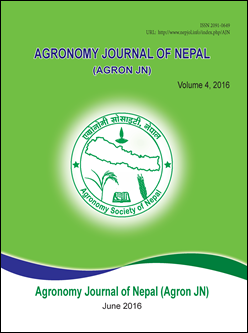Effect of Herbicides and Sesbaniaco- Culture on Weed Management and Grain Yield of Direct Seeded Rice Variety Khumal-4 at Khumaltar Condition, Nepal
DOI:
https://doi.org/10.3126/ajn.v4i0.15534Keywords:
Sesbania co-culture, Direct seeded rice, Herbicides, Grain yield and yield components of riceAbstract
Field experiments were conducted at the experimental field of Agronomy Division, Khumaltar, Nepal during 2012 and 2013 to find the effect of different herbicides on weed management and grain yield of direct seeded rice. The experiment was carried out in a Randomised Complete Block Design (RCBD ) with seven treatments in three replications. Khumal-4 rice variety was used with in all the seven treatments viz; W1 = Weedy Check (no weeding) ; W2 = Farmers practice ( two hand weeding) ; W3 =Pyrazosulfuron (pre) @ 20 g a.i /ha fb (followed by ) Bispyribac (post-emergence (post) @ 25 g a. i / ha ; W4 = Pyrazosulfuron (pre) @ 20 g a.i /ha fb Bispyribac (post) @ 25 g a. i / ha fb 2, 4 –D; W5= Oxadiargyl (pre-emergence (pre) @ 90 g a.i/ha fb Bispyribac (post) @ 25 g a. i / ha; W6 = Oxadiargyl (pre) @ 90 g a.i /ha fb Bispyribac (post) @ 25 g a. i / ha fb 2, 4- D @ 500 g a .i /ha ; W7 = Sesbania (soaked) fb 2, 4- D @ 500 g a.i / ha fb one hand weeding. Rice seeds were directly sown by seed drill machine at seed rate of 30 kg/ha. All the pre emergence herbicides were sprayed on the first day of rice sowing whereas the post emergence herbicides were sown on 20 -25 days after sowing (DAS) by using a knapsack sprayer. Sesbania seed were sown at 30 kg/ha as co-culture with rice on the same day as rice was sown by broadcasting. The Sesbania was knocked down at 30 DAS using 2, 4-D.The yield of rice in 2013 was less than that of 2012 which could be due to the less rainfall and uneven rain distribution during the rice season. The results showed that among the Pyrazosulfuron (pre) @ 20 g a.i /ha fb Bispyribac (post) @ 25 g a. i / ha fb 2, 4 –D was found effective in controlling weed population , biomass and producing highest grain yield of rice 6512 kg /ha in 2012 and 3190 kg/ha in 2013 followed by the treatment Sesbania co-culture (Soaked) fb 2, 4- D @ 500 g a.i/ ha fb one and weeding giving increased rice yield of 6499 kg/ha in 2012 and 2858 kg/ha in 2013.
Agronomy Journal of Nepal (Agron JN) vol. 4, Page: 121-127, 2016
Downloads
3187
1880
Downloads
Published
How to Cite
Issue
Section
License
ASON permits for free use, distribution and reproduction in any medium if the original work is properly cited and not used for commercial purposes.




